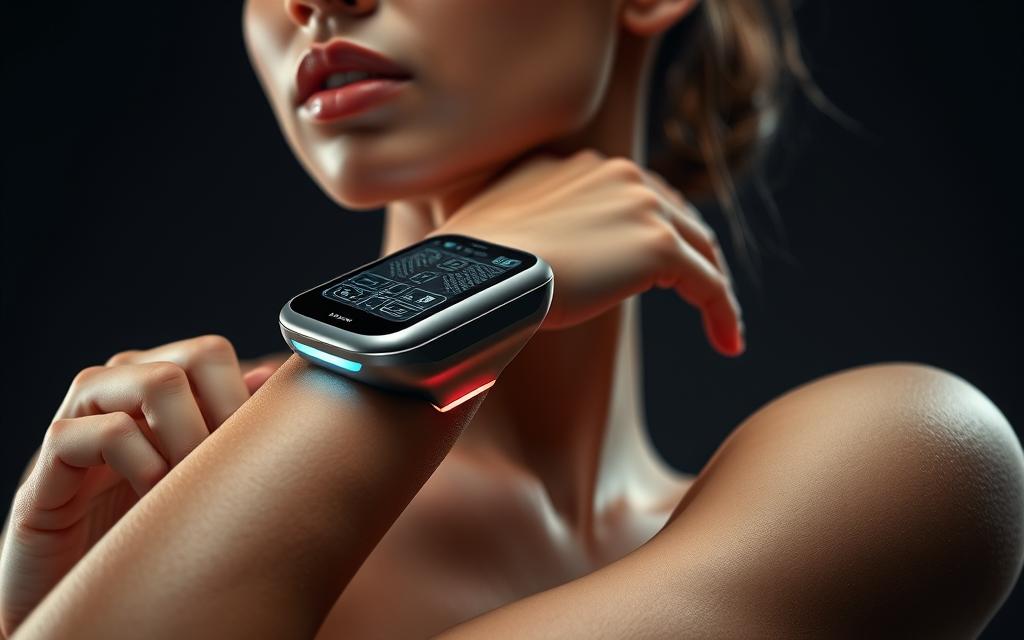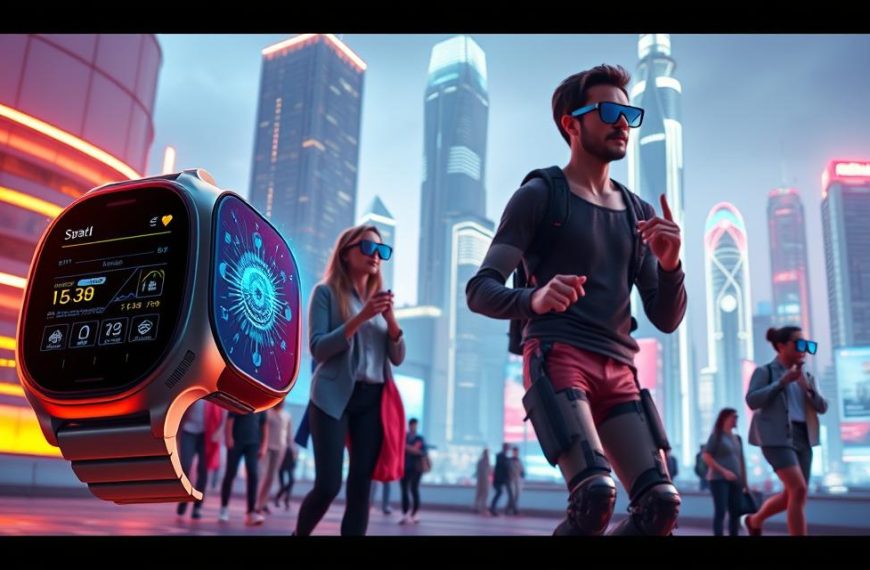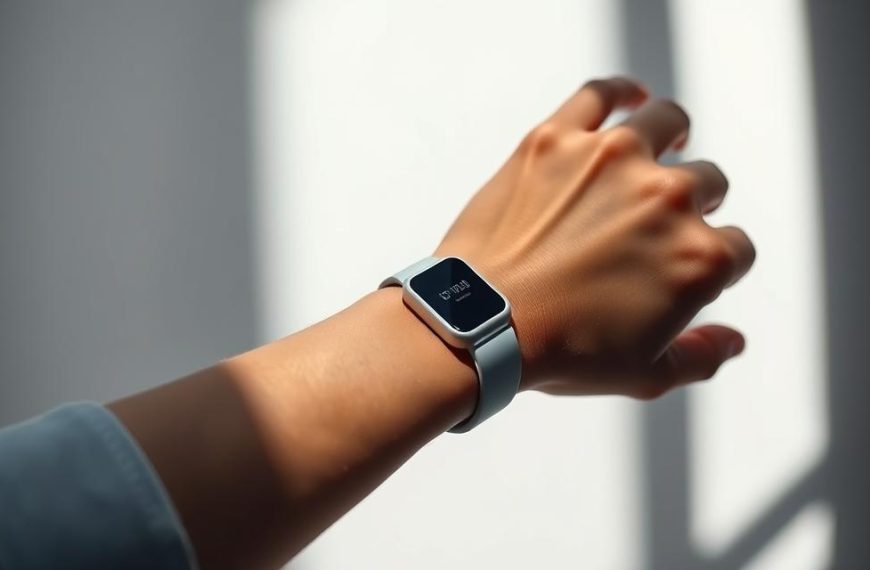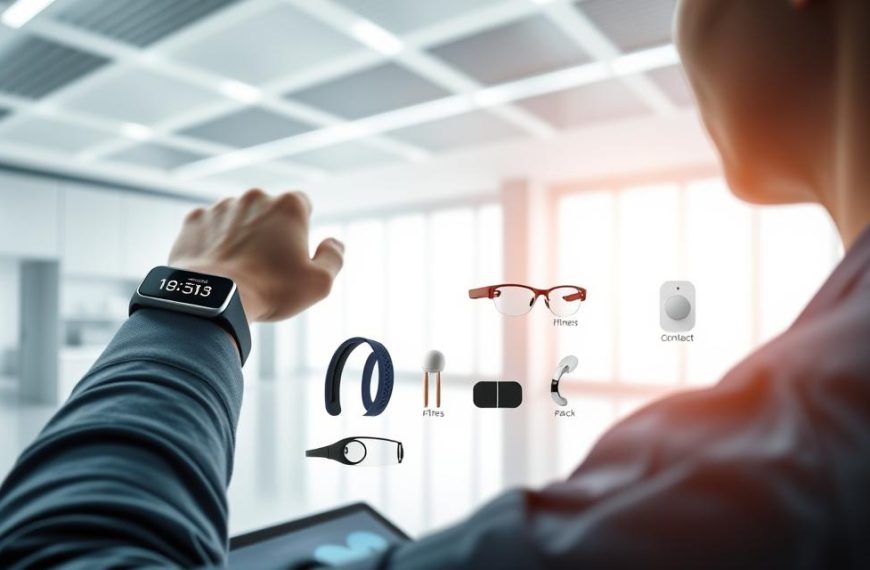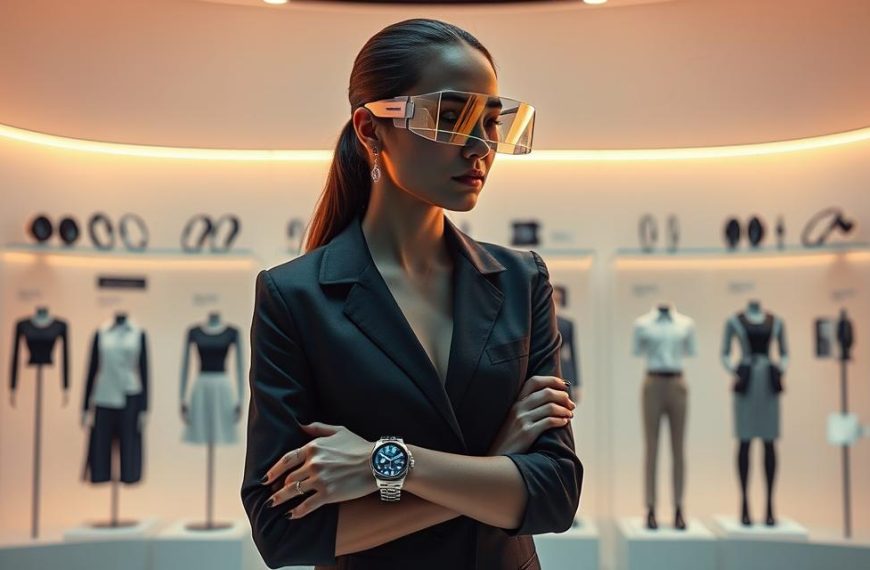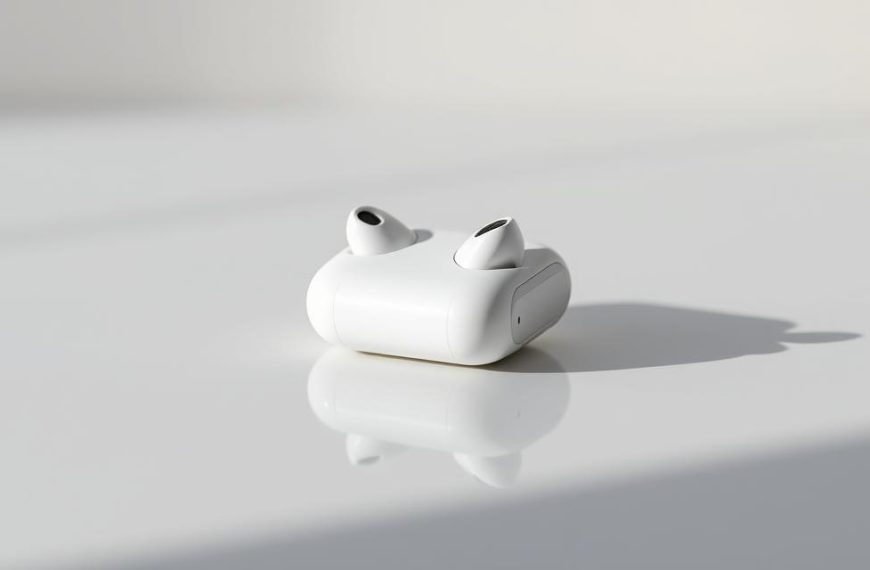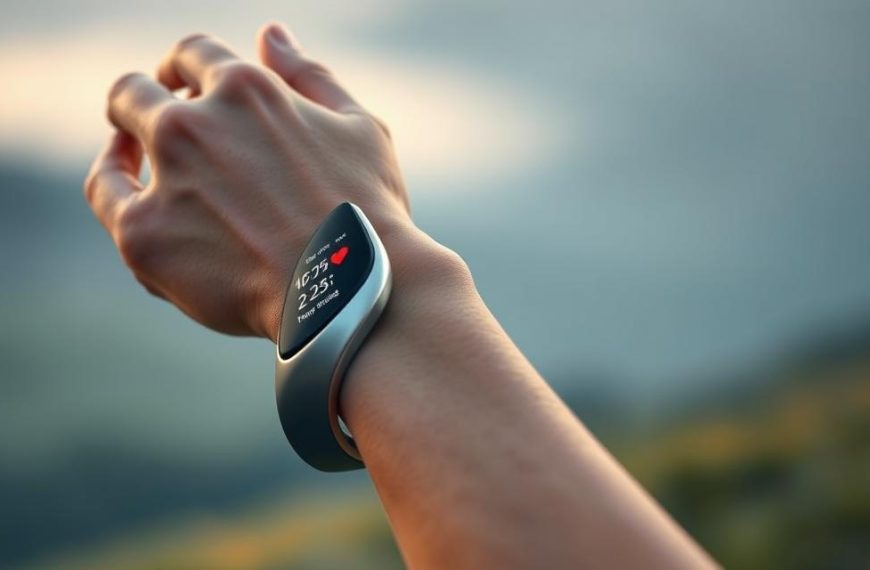The wearable tech sector is evolving at an unprecedented pace. With a projected market value of $151.8 billion by 2029, this industry is reshaping how we live and work. From healthcare to workplace safety, these devices are becoming essential tools in modern life.
AI integration and miniaturization are driving this growth. These innovations enable smarter, more efficient devices. For example, 82% of U.S. consumers now prioritize wellness, fueling demand for health-focused wearables.
Emerging trends like AR glasses and sustainable designs are setting the stage for the future. These advancements promise to make wearable tech more accessible and impactful than ever before.
Introduction to Wearable Technology
From smartwatches to biosensors, tech is transforming daily life. These devices are no longer just accessories; they are powerful tools for managing health and wellness. The global market for medical wearables is projected to grow from $35.6 billion in 2023 to $151.8 billion by 2029, driven by a 27.5% CAGR.
Modern innovations have evolved far beyond basic pedometers. Today’s gadgets include AR glasses, biosensor patches, and AI-powered diagnostic tools. These advancements are fueled by factors like aging populations, the need for remote care, and miniaturization of technology.
Companies like Medtronic are leading the way with continuous vital sign monitoring systems. Additionally, FDA-approved ECG smartwatches can now detect atrial fibrillation, showcasing the potential of these devices in preventive care.
With 82% of U.S. consumers prioritizing wellness, the demand for health-focused wearables continues to rise. These tools are not just about convenience; they are reshaping how we approach personal health management.
Key Innovations Driving the Wearable Tech Revolution
Cutting-edge wearable sensors are transforming how we track and manage health. These devices are no longer limited to basic functions; they now offer advanced features like continuous vital sign collection and AI-driven predictive analysis. This represents a significant leap in healthcare technology, enabling better care and improved outcomes for patients worldwide.
Continuous Vital Sign Collection
Medtronic’s 24/7 vital sign tracking technology reduces gaps in clinical observation. This innovation ensures continuous monitoring of critical metrics like blood pressure and oxygen levels. As Frank Chan notes, “This approach minimizes risks and enhances patient safety.”
Microfluidic Patches
Fujitsu’s microfluidic patches analyze biomarkers without invasive blood draws. These sensors use sweat to provide real-time data on hydration, glucose levels, and more. This non-invasive method is a game-changer for chronic disease management.
Wearable ECGs
Redwerk’s ECG wearables detect stroke risks through app-connected data. Unlike traditional Holter monitors, these devices offer continuous monitoring and real-time alerts. They track heart rate and detect irregularities, enabling timely interventions.
Continuous Glucose Monitoring
Dexcom G7 and Abbott’s FreeStyle Libre 3 are leading the way in glucose monitoring. These sensors provide automatic insulin delivery alerts and offer a 14-day wear time. They empower patients to manage diabetes more effectively.
AI-Driven Predictive Analysis
AI processes ECG data to predict cardiac events, enhancing the quality of care. This technology analyzes patterns and provides actionable insights, helping doctors make informed decisions. The rate of innovation in this field is accelerating, promising even more breakthroughs.
| Innovation | Key Feature | Benefit |
|---|---|---|
| Continuous Vital Sign Collection | 24/7 tracking | Reduces clinical observation gaps |
| Microfluidic Patches | Non-invasive analysis | Enables sweat-based health analytics |
| Wearable ECGs | Real-time alerts | Detects stroke risks |
| Continuous Glucose Monitoring | 14-day wear time | Improves diabetes management |
| AI-Driven Predictive Analysis | Cardiac event prediction | Enhances patient care |
For more insights on emerging wearable health technologies, visit this Forbes article.
Applications of Wearable Technology in Healthcare
Healthcare is being reshaped by innovative devices that offer real-time insights. These tools are transforming how patients receive care and how providers manage health conditions. From remote monitoring to AI-powered systems, the impact is profound.
Remote Patient Monitoring
Remote patient monitoring (RPM) is reducing hospital readmissions by 63%, according to Plaza Dynamics. Devices like Philips’ BioTelemetry detect cardiac arrhythmias, enabling timely interventions. Current Health’s FDA-cleared platform allows home monitoring, improving access to care.
Integration with Electronic Health Records (EHRs)
Smart patches and devices now transmit data directly to EHR systems like Epic and Cerner. For example, Apple Watch HealthKit integrates with Epic Systems, ensuring seamless data flow. This integration enhances care coordination and reduces errors.
AI-Powered Patient Monitoring
AI is revolutionizing patient monitoring by reducing false alarms and predicting health risks. A Johns Hopkins study found AI reduces ICU false alarms by 23%. EY’s AI system cuts care costs through predictive alerts, offering actionable insights for providers.
These advancements are not just improving care; they are setting new standards in healthcare management. From chronic disease support to PTSD management, wearable devices are proving indispensable.
Wearable Technology in Fitness and Lifestyle
Fitness and lifestyle are being revolutionized by cutting-edge gadgets. These devices are designed to enhance daily routines, offering insights into physical activity, sleep, and overall health. With advanced features, they empower users to take control of their well-being.
Fitness Trackers and Smartwatches
Fitness trackers and smartwatches are leading the charge in this transformation. Brands like Garmin and Polar offer devices tailored for athletes, such as the Garmin Epix Pro and Polar Vantage V3. These tools provide detailed metrics like heart rate, stride length, and recovery time, helping users optimize their performance.
Whoop 4.0’s strain and recovery algorithm is another standout feature. It analyzes workout intensity and recovery needs, offering personalized feedback. Similarly, Fitbit’s Stress Management Score uses EDA sensors to measure stress levels, providing actionable insights for better health management.
Personalized Fitness Coaching
AI-powered coaching is changing the game for fitness enthusiasts. According to the American College of Sports Medicine, users with AI coaching show 41% higher workout consistency. Devices like Peloton Guide use motion tracking to correct form, ensuring safer and more effective workouts.
Amazfit Balance takes it a step further with its readiness score. This feature combines biometric data like sleep quality and activity levels to determine the best time for exercise. Such innovations make fitness more accessible and tailored to individual needs.
Stress Management Tools
Stress management is a key focus for modern wearables. The Oura Ring Gen4 tracks heart rate variability (HRV) with 86% accuracy, offering insights into stress levels. Garmin’s Body Battery feature combines stress, sleep, and activity data to provide a comprehensive energy score.
These tools not only improve physical health but also enhance mental well-being. As research shows, managing stress effectively can lead to a better quality of life. For more insights on how these devices are transforming fitness and lifestyle, visit this detailed guide.
Smart Glasses and Augmented Reality (AR)
Augmented reality is reshaping industries with its transformative capabilities. From professional training to healthcare, AR is enhancing how we work and learn. These technologies are not just futuristic concepts; they are practical tools driving efficiency and innovation.
AR Glasses in Professional Training
Boeing uses RealWear HMT-1 for hands-free access to repair manuals. This approach reduces errors and saves time. Similarly, Siemens Energy employs AR annotations for remote turbine repairs, enabling experts to guide on-site teams effectively.
Microsoft HoloLens 2 has proven its value in aircraft maintenance, cutting repair errors by 32%. These applications highlight the future of professional training, where AR glasses provide real-time guidance and support.
AR Applications in Healthcare and Education
In healthcare, AR is revolutionizing patient care. AccuVein’s AR vascular visualization helps nurses locate veins with precision. Medivis AR Surgical Platform enhances anatomy visualization, improving surgical outcomes.
Case Western Medical School uses AR for anatomy lessons, offering students a detailed view of the human body. These tools are transforming education, making complex concepts easier to understand.
Enhancing Workplace Efficiency with AR
AR is boosting productivity across industries. Meta Orion glasses allow engineers to manipulate 3D CAD models, streamlining design processes. Vuzix M400 and Magic Leap 2 are setting new standards for industrial applications.
These technologies are not just improving workflows; they are redefining how teams collaborate. By integrating AR into daily operations, businesses are taking a significant step toward a more efficient future.
Sustainability and Customization in Wearable Tech
Sustainability and customization are becoming key drivers in the evolution of modern devices. As consumers demand more eco-conscious options, manufacturers are stepping up with innovations that reduce environmental impact while enhancing user experience. From extended battery life to modular designs, these advancements are shaping the future of the industry.
Eco-Friendly Materials and Manufacturing
Companies are adopting eco-friendly practices to minimize their carbon footprint. Garmin’s solar charging technology extends battery life by 300%, reducing the need for frequent recharging. Similarly, Apple Watch bands made from ocean-bound plastics showcase how recycled materials can be integrated into high-quality products.
Nokia’s graphene-based flexible sensors are another example of sustainable tech. These sensors are not only durable but also energy-efficient, offering long-term benefits for users. Withings ScanWatch 2 takes it a step further with CO2-neutral shipping, ensuring that every aspect of the product lifecycle is environmentally responsible.
Modular Design and Personalization Options
Modular design is revolutionizing how we use wearable devices. Fairphone’s modular smartwatch reduces e-waste by 57%, allowing users to replace individual components instead of discarding the entire device. Blocks, another pioneer in this space, offers a smartwatch with swappable sensors, giving users the flexibility to customize their experience.
Coros Vertix 2’s 60-day GPS battery life is a testament to the capabilities of modular design. This device is tailored for outdoor enthusiasts who need reliable performance without constant recharging. These innovations highlight the growing trend of personalization in the industry.
As the demand for sustainable and customizable tech grows, manufacturers are finding new ways to integrate these features into their products. This shift not only benefits the environment but also enhances user satisfaction, paving the way for a more responsible and personalized future.
Conclusion
The future of healthcare is being reshaped by groundbreaking innovations. With a projected 27.5% market CAGR and a $400 billion wellness industry impact, devices are becoming essential tools for preventive care. By 2026, FDA-cleared AR contact lenses, like those from Mojo Vision, will further revolutionize patient management.
Continuous monitoring through wearables offers unparalleled insights into health. These technologies empower patients and providers alike, enabling early detection and timely interventions. Healthcare systems must adopt these integrations to stay ahead in delivering quality care.
As these innovations advance, ethical AI use in biometric data analysis remains critical. Ensuring privacy and transparency will build trust and drive widespread adoption. The future of healthcare is here, and it’s powered by smart, sustainable devices.

